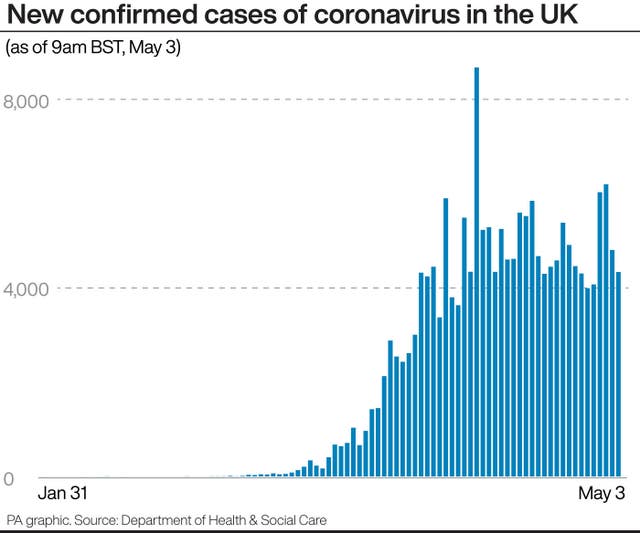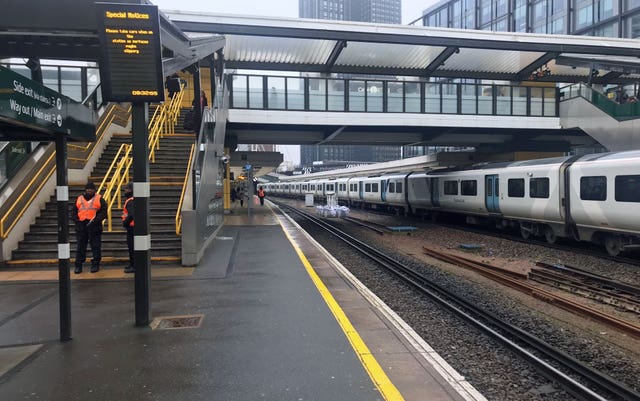
Reduced hot-desking, the closure of office lifts and canteens, and putting tape on the floor to mark where people should stand are among measures being proposed by the Government to get back people back to work.
Draft documents from the Department for Business, Energy and Industrial Strategy (BEIS), seen by the BBC and the Financial Times, say extra cleaning should be introduced in office spaces and the use of protective equipment should be considered where maintaining a distance of two metres between workers is not possible.
For workers who have customer-facing roles, plastic screens should be erected to help protect them, while continued home working and staggered shifts should also be encouraged, the guidance says.
The proposals are among a list of guidelines in seven documents drawn up after consultation with executives, trade bodies and unions.

The Financial Times reported that firms will also be told to lay on more parking spaces so that staff do not have to rely on lifts from colleagues.
Under the plans, millions of companies will have to draw up a Covid-19 “risk assessment” before allowing staff to return to work, the documents suggest.
The guidance also says social distancing will have to be maintained, whether on the shop floor, in shopping queues, or in communal spaces.
A Government spokesman said: “The Business Secretary continues to work with businesses, union leaders and the science and medical community so we can ensure workplaces are safe for those who will go back to work once the measures are relaxed and give people the confidence to return to work.”
Defence Secretary Ben Wallace said a “range of methods” including the use of personal protective equipment (PPE) and shields could allow people to be less than two metres apart for periods.
He told BBC Breakfast: “I think there are lots of ways, there’s PPE, there’s use of time.
“You could be closer than two metres but not for long at all. There are a range of ways to do this.
“And if it’s very vital you work next to each other then potentially things like shields that you see in supermarkets, or indeed PPE, is a way forward.”
But business leaders said clarity is needed on issues such as PPE and whether firms can be held liable even if they fulfil their obligations to protect employees from coronavirus.
️✍️As @GOVUK prepares to outline its plans to gradually reopen the economy, our President, Baroness Ruby McGregor-Smith, says that "this is a time to be bold."
Read our open letter to PM @BorisJohnson and our principles for restarting the economy 👇https://t.co/pJb8B72dtB pic.twitter.com/L73gLd1Jj5
— BCC (@britishchambers) May 3, 2020
Director-general of the British Chambers of Commerce Adam Marshall said the issue is one of the “key questions we’ve asked”.
He told BBC Radio 4’s Today programme: “We need as much specificity as possible so businesses can ensure they’ve taken all the steps they can in order to protect their people.
“They (bosses) will want to know that they’re not going to be held liable for horrible things that may unfortunately happen if they’ve done everything in their power to keep their people safe.
“Whereas, by contrast, you’d want to see those employers who didn’t take adequate steps face the consequences of that so the question of legal liability is extremely important.”
Mr Marshall said there is a need for “clear guidance” on PPE and a UK-wide strategy.
“We’re still waiting for more detail on that and it’s going to be hugely, hugely important for a lot of firms because the number of questions we’re hearing from businesses about protective equipment grows by the day,” he told Today.
In other developments:
– Mr Wallace said the Government has been “trying to source as many masks as possible” in case guidance for their use by the public changes.
– Education Secretary Gavin Williamson announced a package of support worth almost £3 billion to help universities weather the coronavirus crisis.
– A smartphone app to trace the spread of coronavirus will be trialled on the Isle of Wight this week before being rolled out more widely later this month.
– Former Government chief scientific adviser Sir David King will host a meeting of experts on Monday in response to concerns over the “lack of transparency” coming from the Sage group of advisers.

Meanwhile, rail union leaders have voiced “severe concerns” over any moves to increase train services as part of the expected easing of the lockdown.
The three main rail unions have written to Prime Minister Boris Johnson warning that increasing services would send out a “mixed message“ that it is OK to travel by train, despite official advice suggesting otherwise.
“This mixed messaging could be dangerous and lead to the public flouting the rules on travel and work,” said Aslef, the RMT and TSSA.
The letter continues: “We will not accept new working patterns that put the lives of railway workers and passengers at risk.
“To be clear – we are not convinced that there is any basis at this time for a safe escalation of services.”
The Prime Minister is due to set out a new strategy on Sunday with more details on how the lockdown will be eased following a review of the current arrangements on Thursday.
In a video message on Twitter on Monday, Mr Johnson said it was important to meet the five tests set by the Government before restrictions are eased.
“We will only be able to move on to the second phase of this conflict if our five tests have been met,” he said.
“The worst thing we could do now is ease up too soon and allow a second peak of coronavirus.”
In an interview with The Sun newspaper, Mr Johnson, who was treated in intensive care for Covid-19 last month, told how he feared he might not live to meet his son Wilfred, who was born on Wednesday.

Enjoy the convenience of having The Sunday Post delivered as a digital ePaper straight to your smartphone, tablet or computer.
Subscribe for only £5.49 a month and enjoy all the benefits of the printed paper as a digital replica.
Subscribe